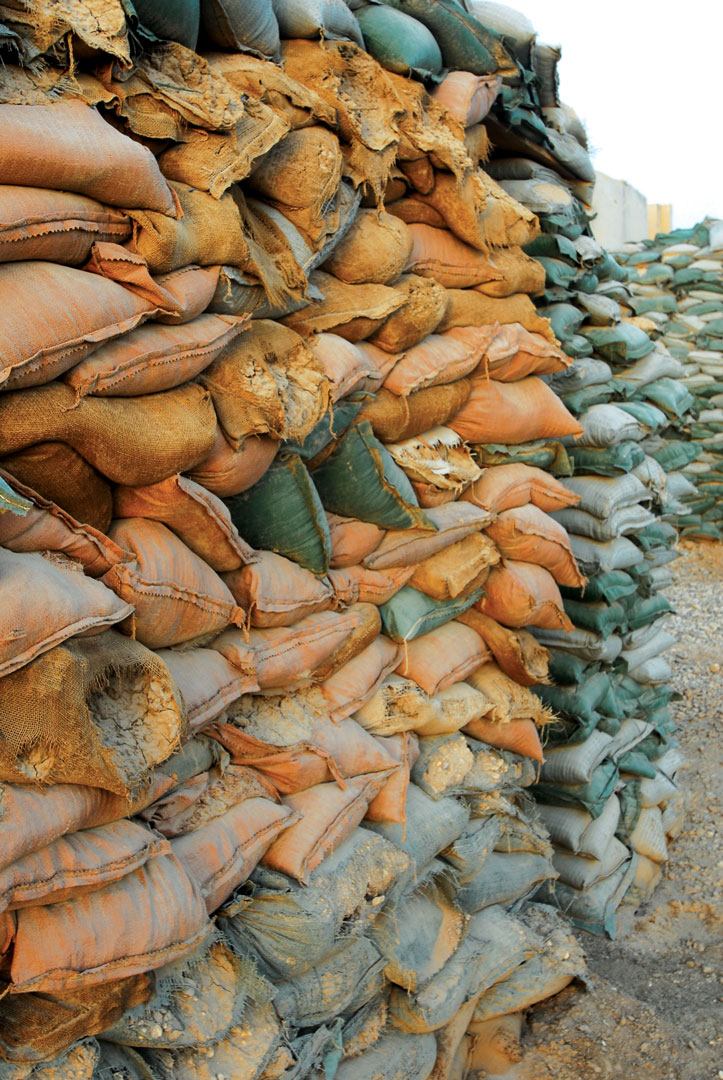
PROTECTORS OF COMPETITION: When a sole-source award for Humvee control unit components was challenged, GAO found that the Army didn’t know the minimum quantity needed, and had made no effort to determine that number. The FAR instructs contracting officials to act affirmatively to obtain and safeguard competition, rather than taking a passive approach. (Photo by Sgt. Samuel Hartley, 131st Mobile Public Affairs Detachment)
In defense acquisition, you can’t always get what you want.
by Dennis Longo
The seventh and final article in the On Contracting series, based on the Competition in Army Contracting course developed by the author for the Office of the Deputy Assistant Secretary of the Army for Procurement.
While on deployment in 2003, my commander told me more than once with regard to procurement requirements, “It got here yesterday, you work on it today, and you get it here tomorrow.” In other words, we received the procurement requirement yesterday, you work on the procurement requirement today, and you get the items here tomorrow. The focus of our procurement efforts in theater was an urgency to obtain goods and services immediately to sustain successful military operations.
We’ve been in wartime mode since the turn of the century, and that urgency mantra continues to ripple throughout Army acquisition. Labeling procurement requirements as urgent seems to be the “usual” practice in our current high-paced era of increasing international conflicts and emerging threats. It seems that, no matter what the environment, no contract action may be set aside for another day irrespective of your workload or those meetings and conferences you have scheduled.
Ask the requiring activity or program manager if the request for a sole-source contract action that he or she submitted today may be delayed for a few days and the answer will be an unconditional “No” without hesitation. That may, perhaps, be for good reason, but federal procurement regulations are intended to limit competition based on unusual urgency, not on usual urgency.
When the urgency of a procurement requirement results in a decision to restrict full and open competition to one or a limited number of sources, that urgency must be “unusual” and not merely pose a risk of an unacceptable delay. The urgency must be so unusual, in fact, that the government is compelled to take the extraordinary action to limit competition simply because there’s not enough time to solicit and award a contract for the requirement using normal competitive procedures.

WOULD YOU LOOK AT THE TIME?: Limiting full and open competition by awarding a sole source contract must not be based on a lack of advance procurement planning. Acquisition planning should begin as soon as the agency need is identified, preferably well in advance of the fiscal year in which contract award or order placement is necessary. (Photo by Getty Images)
The Federal Acquisition Regulation (FAR) identifies such an urgency as “unusual and compelling urgency,” and one where the United States would be “seriously injured” unless the number of sources solicited is limited, according to FAR 6.302-2. B-243382.3 Durodyne Inc.
Restricting competition because an unusual and compelling urgency exists is an authorized exception to the full and open competition requirements of the Competition in Contracting Act, implemented at FAR 6.302-2. However, federal procurement regulations don’t define urgency as it relates to restricting competition for the government’s procurement requirements. One may reason that, if one can simply explain the need to procure a particular item or service quickly, competition requirements may be waived.
The Government Accountability Office (GAO) has provided some guidance as to what circumstances may result in an unusual and compelling urgency and as we’ll see in each of the following examples, unusual compelling urgency is not always defensible.
RULE NO. 1
Limiting full and open competition must not be based on a lack of advance procurement planning.
FAR 7.102 requires federal agencies to perform acquisition planning and conduct market research for all acquisitions. Typically, acquisition planning should begin as soon as the agency need is identified, preferably well in advance of the fiscal year in which contract award or order placement is necessary. See FAR 7.104(a).
Example 1
The Navy had been working on the performance requirements for a replacement contract, issued a solicitation, realized the solicitation requirements we not adequately defined, and canceled the solicitation. Because these contracts would expire within a matter of weeks, performance under both contracts was extended on the basis of “urgent and compelling circumstances.”
In 1996, New Breed Leasing submitted a protest to the GAO, complaining that there was no rational basis for the sole-source extensions, and that the sole-source contract extensions resulted from a lack of advance planning.
In response to the protest, the Navy claimed it hadn’t realized that both solicitations’ requirements were not adequately defined until the end of July 1996. Consequently, because both contracts would expire Sept. 30, 1996, both required an extension for an entire year because the requirement must undergo “a thorough and comprehensive review and rewrite.”
It turns out that the solicitation requirements for the follow-on contract were identified in July 1994, the acquisition plan was approved June 1995, proposals submitted in response to the solicitation were submitted by October 1995, and proposal evaluation was completed by June 1996. When the contracting officer sought approval from headquarters in July 1996 to proceed with negotiations, headquarters expressed its concern that the request for proposal lacked definitive task descriptions. The Navy canceled the solicitations on Aug. 8, 1996, and subsequently extended both contracts. In essence, the Navy realized that the solicitations were flawed more than a year after the solicitations were issued and more than eight months after proposals were submitted.
The protest of the Navy’s action to the GAO was sustained because the contract action resulted from a lack of advance planning. B-274201 New Breed Leasing.
“Advance procurement planning” may appear redundant. One could reason that all planning is done in advance. But the FAR intends procurement planning to be conducted well in advance; not momentarily or spontaneously. When procurement planning is not conducted in advance or timely, such planning may be unreasonable. B-288107, Signals and Systems Inc.

A FAILURE TO PLAN: Even if half of your employees retired tomorrow, urgency caused by personnel turnover and an inexperienced staff is not adequate rationale to support unusual and compelling urgency. (Photo by Getty Images)
Example 2
The Army had been reporting safety messages regarding the vehicle control unit, a protective control box in the Army’s Humvee, since 1999. The control unit had caused the vehicle’s starter to crank on its own, causing the batteries to drain of their power, short out and catch fire, and potentially destroy the vehicle. Because replacements for the vehicle control units were needed immediately, and anticipating that the issuance of the safety message would create a significant demand for a replacement electrical starter system, the Army executed a justification to limit full and open competition based on unusual and compelling urgency and awarded a sole-source contract to a single firm to obtain replacement vehicle control units.
In April 2001, an Army deputy for system acquisitions decided that all vehicle control units, of any version, would be replaced as soon as the stock was available, and a second sole-source contract was awarded to procure the needed units. The sole-source justification supporting this second sole-source contract was approved on the basis of unusual and compelling urgency.
A protest challenging both sole-source contract awards was submitted to the GAO. The GAO found that the Army didn’t know the minimum quantity necessary to satisfy its immediate urgent requirement because it did not know how many control units were still in the field and would have to be replaced. Despite this lack of knowledge, the Army made no effort to determine how many control units were in place and there was no explanation why the Army couldn’t determine the number of units to be replaced.
Sustaining the protest, the GAO found that the Army failed to conduct reasonable procurement planning. Knowing of safety concerns with a vehicle control system that would have to be replaced, the Army took nearly two years to draft performance specifications.
Key point. Contracting officials must act affirmatively to obtain and safeguard competition; they cannot take a passive approach and remain in a noncompetitive position where they could reasonably take steps to enhance competition. B-288107 Signals and Systems Inc.
In each of the prior examples, the government’s actions to issue sole-source contracts resulted from a failure to conduct advance procurement planning.
RULE NO. 2
Urgency caused by personnel turnover and an inexperienced staff is not adequate rationale to support unusual and compelling urgency.
Significant decreases in personnel resulted in the Defense Mapping Agency awarding a contract for grounds maintenance services for sites in Virginia and Maryland by authority of a justification to limit full and open competition under unusual and compelling urgency because the Defense Mapping Agency didn’t have enough time to prepare the work description for a competitive procurement. The agency’s incumbent contract for grounds maintenance services expired on Sept. 30, 1992.
The agency explained, in its justification to limit full and open competition, that it was unable to procure a replacement contract using full and open competition by Oct. 1, 1992, because the requiring activity was unable to prepare a timely statement of work because of personnel vacancies, inexperience of existing staff and an excessive backlog of work.
The award was protested to the GAO.
After reviewing the protest, GAO concluded that the award was improper and sustained the protest, ruling that agency personnel turnover and inexperience cannot justify a noncompetitive procurement based on urgency. In GAO’s view, a failure to promptly draft adequate specifications and “an excessive backlog of work” are both unacceptable justifications. B-252614 TLC Services.
Key point—Government personnel turnover and inexperience essentially recognize the lack of planning and merely provide an excuse based on the limitations of the agency’s personnel.
RULE NO. 3
Risk to military operations or human safety is an important element justifying limiting competition based on unusual and compelling urgency.
Certain items of military hardware and weaponry may be needed quickly to support mission operations in theater. The government should not risk injury to personnel or property in order to conduct a competitive acquisition when there is a critical need for certain supplies or services to support military operations. B-402908 Argon ST Inc..
Circumstances of unusual and compelling urgency because a critical need exists for certain supplies or services impacting military operations is an important factor that may support restricting full and open competition. B-243067 Lundy Technical Center Inc.

WELL, THAT’S UNUSUAL: In 2004, the government had an urgent need for more polypropylene sandbags in Iraq. Existing bags had deteriorated more quickly than expected, and more bags were needed to reduce the risk to military operations and human safety. GAO supported the agency’s decision to award four non-competitive contracts because of the urgent and unusual need. (Photo by 1st Lt. Kelly McManus, 1st Armored Brigade Combat Team)
Example
The polypropylene sandbags used in Iraq had deteriorated at an unexpectedly fast rate. In addition, more of the sandbags were needed to meet force-protection requirements. In November 2004, the government agency requiring these sandbags awarded four noncompetitive contracts on the basis of unusual and compelling urgency because the United States would be seriously injured unless it limited the number of sources. A current, although unsuccessful, firm manufacturing these sandbags for the government under a separate government contract protested the awards to the GAO, complaining that it should have been solicited for the requirement.
The GAO found that the urgency of the requirement was caused by the unexpected rapid deterioration of sandbags, the increased demand for sandbags in Iraq, and the performance problems experienced on the protester’s current contract.
The contracting officer decided to restrict the current manufacturer from receiving an award for the urgent requirement because of the delinquent deliveries under its existing contract, the outstanding questions concerning the acceptability of its offered sandbags, and the fact that, even if that manufacturer were able to resolve the delinquency and acceptability of its products, it still would not have been able to complete delivery under its contract until March 2005, which further jeopardized the safety of military personnel. B-295434 Total Industrial & Packaging Corp.
In short, you may not always get what you want, but you get what you need.
RULE NO. 4
The work to be performed may not exceed the government’s minimum needs.
The total period of performance of a contract action using the unusual and compelling urgency authority may not exceed the time necessary to meet the unusual and compelling requirements of the work to be performed under the contract action.
Example 1
The award of a sole-source bridge contract for home management and marketing services issued by the U.S. Department of Housing and Urban Development (HUD) was protested to GAO. The contract included a four-month base performance period and two four-month option periods. Chapman Law Firm protested the award, complaining that the term of the bridge contract exceeded HUD’s minimum needs. HUD explained, however, that the term of the contract and its two four-month option periods were necessary in light of the possibility that the litigation surrounding the requirement would become protracted. HUD noted that litigation surrounding the award of these services in other areas of the United States had lasted as long as nine months. GAO agreed and denied the protest. Given this history of litigation, the contract did not exceed the agency’s minimum needs at the time of the award. B-296847 Chapman Law Firm Co..
Example 2
Faced with the urgent need to obtain control room services, the U.S. Food and Drug Administration (FDA) awarded a six-month sole-source contract in 1985 with a source it determined was the only source capable of performing the required work immediately.
The FDA justified the need to obtain control room services as urgent and compelling circumstances. The contract included options allowing the FDA to extend contract performance up to two additional 12-month periods and an additional 5.5-month period. IMR Systems protested the FDA’s sole-source contract to GAO, complaining that the FDA didn’t request offers from other potential sources. Although the GAO ruled that the action was reasonable, it also found that the urgent and compelling circumstances failed to justify the 5.5-month option period. B-222465 IMR Systems.

REMOVE BEFORE FLIGHT: The Cessna T-37 is a trainer aircraft used by the Air Force for more than 50 years, until it was retired in 2008. In 1990, the service awarded sole source contracts to two suppliers few replacement fuel cells, but GAO determined that the contract provisions included unnecessary standards for extensive flight testing of the parts. (Photo by Harry Toneman, U.S. Air Force)
Example 3
The Air Force determined in May 1990 that T-37 fuel cells for its training aircraft were urgently needed. It awarded a contract to each of two previously approved sources. The justification to limit full and open competition was based on unusual and compelling urgency to avoid a critical impact on the availability of its T-37 training aircraft and, because any other firm would need to have its fuel cell successfully flight tested for 300 hours in order to qualify, competition was limited to only the previously approved sources. A protest of the awards was submitted to the GAO, complaining that the flight testing requirement unnecessarily restricted competition. The GAO sustained the protest because the Air Force could not explain why the 300-hour flight testing requirement was necessary for all firms that had not produced T- 37 fuel cells. Essentially, the Air Force included restrictive provisions that exceeded its minimum needs. B-239837, B-239839 Engineered Fabrics Corp..
Key point. Understand the government’s minimum essential needs and clearly articulate in the justification why those needs are essential. Any need beyond the government’s minimum essential needs does not justify limited competition.

WAITING UNTIL THE LAST MINUTE: The FAR intends procurement planning to be conducted well in advance; not momentarily or spontaneously. When procurement planning is not conducted in advance or in a timely manner, such planning may not be seen as reasonable. (Photo by Getty Images)
RULE NO. 5
Properly documenting the rationale for limiting competition on the basis of unusual and compelling urgency will expedite the government’s response to satisfy its needs.
The information necessary to accurately document the rationale to limit competition based on unusual and compelling urgency may not be readily available, particularly when the urgency affects military operations or personnel safety. Here are some elements that should be addressed in a justification limiting competition based on unusual and compelling urgency:
- Explain why the requirement is urgent and how it compels the government to take the unusual approach to pursue a sole-source action and exclude all other sources from competing for the requirement.
- Identify the serious injury the government will sustain if the action to limit competition is delayed, including risk to personnel safety or risk to mission failure.
- Discuss the circumstances of the urgency and how it occurred.
- Identify when we were first made aware of the urgent need.
- Characterize the urgency by explaining why we are taking action now to limit competition.
- If procuring items, identify the quantity of those items and how we determined that the stated quantity meets the government’s minimum, urgent need.
- If procuring services, identify the unique and essential performance requirements of those services and how we determined those performance requirements will meet the government’s minimum, urgent need.
- Identify the date when the items or services must be provided and why no other date will suffice.
- Describe how the government will be seriously injured if we don’t procure the items or services from one or a limited number of sources.
- Discuss why only one or a limited number of sources can satisfy the government’s urgent need.
- Discuss the capability of sources to deliver the required items or services.
- Identify the estimated cost of the items or services and how that cost was calculated.
We have a regulatory requirement to separate our wants from our needs when it comes to procuring goods and services. The government’s procurement requirements must be written to the extent necessary to satisfy the needs of the agency or as authorized by law and not its ambitious desires.
For more information on unusual and compelling urgency and other exceptions to the Competition in Contracting Act, go to the Competition in Army Contracting training on the Procurement.Army.Mil – LearningCenter at https://go.usa.gov/xF3kH.
DENNIS P. LONGO retired from Army Contracting Command, Aberdeen Proving Ground (APG), Maryland, on July 31, 2021, after 39 years in public service. He was advocate for competition, task and delivery order ombudsman and senior procurement analyst at the Army Contracting Command at APG. A member of the Army Acquisition Corps, he holds a bachelor’s degree from the University of Baltimore, is Level III certified in contracting and acquisition, and his assignments include acquisition specialist at the Program Manager for Chemical Demilitarization and procurement analyst at the U.S. Army Legal Services Agency. He served in the military from 1971 to 1973 at the Southern European Task Force – Italy, and deployed to Iraq as a civilian in 2003. He authored the Defense Acquisition University (DAU) Continuous Learning DOD Purchase Card Tutorial in 2002, the DASA (P) Competition in Army Contracting course in 2019 and the DAU CON 0160 Competition in Contracting course in 2020. He taught courses on competition in contracting since 2004. The first of the author’s On Contracting articles appeared in the Winter 2020 edition of Army AL&T.







